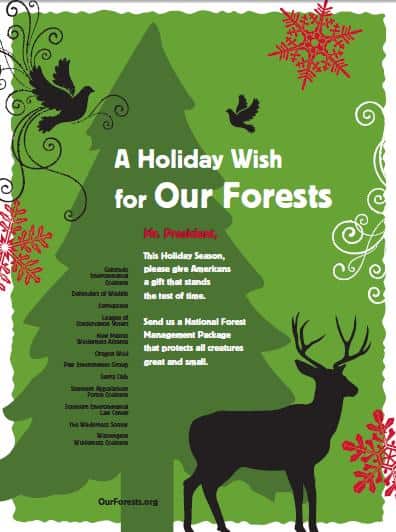
This is the last in a series of posts about assessments for Forest/Grassland plan revisions under the proposed Forest Service planning rule. The posts are a summary of this working draft of the asssessment process. In previous posts, Part 1 described some suggestions about how the assessment process would focus on a series of questions derived from the rule. Part 2 talked about the analysis and deliberation steps. Part 3 described futuring and scenario planning.
Before revising a Forest Service plan, the proposed planning rule requires an assessment – both a product (the document), and a participatory process (deliberation and analysis). There are three important outcomes of the assessment process:
- It can provide baseline information for looking at the effects of a Forest Plan.
- It can provide actionable knowledge about the need to change the Forest Plan.
- As part of a broader adaptive governance framework, it can foster collaborative learning, especially when there is no agreement on the problems or solutions.
The assessment sets the stage for the subsequent proposed plan, an Environmental Impact Statement (EIS), and the who, what, when, where, why and how for the NEPA process. The interplay between the assessment document and the EIS is of particular interest. As a comprehensive look at the planning rule requirements, the assessment would look at the current plan and serve as a screening process for an EIS. This would simplify the EIS since it would only need to focus on those requirements that the current plan isn’t expected to meet. The assessment could also essentially become the “affected environment” chapter of the EIS.
Several points need emphasis. First, the topics covered in an assessment are at the scale of the Forest Plan decision under NFMA and its implementing rule. The level of detail required to develop a Forest Plan is less specific than resource planning (like fire planning or forest-wide recreation planning) or project planning. Second, an assessment is time sensitive. It provides information for the subsequent plan revision and EIS. The rule assumes a more or less continuous cycle of assessment, plan revision or amendment, and monitoring. An assessment is a time step for those issues that are ripe for discussion.
“Actionable knowledge,” as researcher Chris Argyris has written in his 1993 book, “is not only relevant to the world of practice, it is the knowledge that people use to create that world”. A forest plan assessment needs to provide information about what needs to be changed in the forest plan, and how those changes should be made. An assessment shouldn’t merely be a compilation of “descriptive” facts about a forest. The descriptive facts should be connected together in the context of the assessment questions and the experience and judgment of the participants. We might know that there are 10,000 acres of dead trees in a forest. But just knowing that there are dead trees doesn’t compel us to act. However, if we have Forest Service employees, scientists, local residents, or others with experience about disease agents and how they might spread, within the context of a specific assessment question about wildlife habitat or timber salvage markets, we now have actionable knowledge that can inform how the forest plan might be changed.
Argyris has said that actionable knowledge includes a deliberate, intentional search for error, understood as a mismatch between either intentions or assumptions and outcomes. In a sense, these errors are surprises that we didn’t know about or think about when we wrote the original plan. The whole idea of actionable knowledge is about having a reasonable process that facilitates timely recognition of likely, yet unpredictable surprises so that less costy actions are possible in response. Actionable knowledge is about looking to learn, instead of assuming that what we think we know during a planning process will always be the case as we move forward. The context in which we manage these public lands is just too dynamic for such assumptions.
An important theme of the planning process in the proposed rule is learning:
This new framework is science-based and would provide a blueprint for the land management process, creating a structure within which land managers and partners could work together to understand what is happening on the land, revise management plans to respond to existing and predicted conditions and needs, and monitor changing conditions and the effectiveness of management actions to provide a continuous feedback loop for adaptive management.” Federal Register p. 8487
Ideally, for adaptive management to work, learning objectives should be explicitly stated and incorporated into the objectives of the forest plan, with monitoring questions and indicators all tied to those objectives. The proposed rule requires the identification of monitoring questions and indicators as part of the assessment process. So it beomes important that participants use the assessment process by formally asking what they want to learn and why.
Elsewhere on this blog, we’ve discussed the need for the Forest Service to establish an adaptive governance framework, and some of the basic principles. As part of that broader framework, the forest plan assessment process can be used to engage stakeholders and allow participants to invest in the planning process. Without such an investment, we will not reach that basic standard of collaboration—are stakeholders, including the Forest Service, willing to live with the proposed changes? Failing to reach that basic standard reduces the willingness to help get the job done and increases the willingness to challenge the decision administratively, legally, or through civil disobedience, such as ignoring new management rules.
The assessment process will require a capacity to collaborate. Based on a study of forest plan revision efforts, Sam Burns and Tony Cheng have developed six essential prerequisites for utilizing a collaborative process:
Is the Forest Service staff aware of collaboration ideas and principles?
Is there an understanding of the social and historical context for collaboration in the planning locale, including community understanding of collaboration and related collaborative capacities?
Is there internal capacity to do collaboration?
Are there clear collaborative expectations?
Are there ways to monitor and adapt the planning process?
Is there a design for how the collaborative process will work?
A collaborative learning process is essential because forest planning often behaves as a classic example of a wicked problem, where there is no definitive statement of the problem, and hence there can be no definitive solution. (See for instance Salwasser’s description of the Sierra Forest Plan amendments). The forest planning process will involve fragmented stakeholders, high-uncertainty, disagreement about the role of science, political engagement, and an ebbing and flowing of Forest Supervisor control. As the assessment process goes through the iterations of deliberation and analysis, The Forest Supervisor should determine if it still helping define the problem, or still building relationships and capacity for subsequent planning and project work. There will be no easy rules of thumb for when the end the assessment process. There are no “right” answers for many of the assessment questions. The proposed planning rule gives some flexibility by allowing the assessment process to overlap with the revision and NEPA process. It also gives the Forest Supervisor the discretion on when to end the process. Hopefully, the Forest Supervisor has communicated early in the process how she/he will decide when to end the process, participants shouldn’t be surprised when management intervention is taken.
The design and implementation of the assessment process needs to have its end in mind. It’s about convening, exploring and learning, in order to act and move ahead. Ultimately it’s not about a plan, it’s about implementing a plan. But you can’t implement until you know what you’re doing. You also can’t implement a plan without support of those affected it. A well designed assessment process can improve the final plan document, provide a fair process for the participants, and foster relationships with people that can later help implement the plan. So let’s begin.








